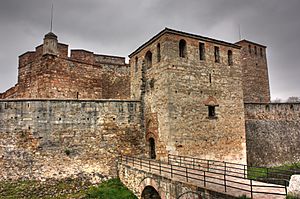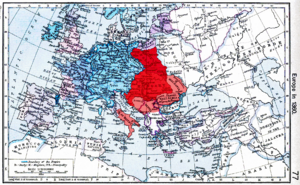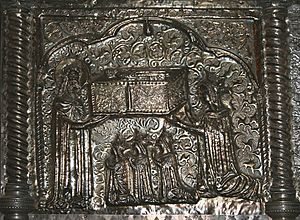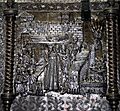Louis I of Hungary facts for kids
Quick facts for kids Louis I the Great |
|
|---|---|
Louis I as depicted in the Chronicon Pictum
|
|
| King of Hungary and Croatia | |
| Reign | 16 July 1342 – 10 September 1382 |
| Coronation | 21 July 1342, Székesfehérvár |
| Predecessor | Charles I |
| Successor | Mary I |
| King of Poland | |
| Reign | 17 November 1370 – 10 September 1382 |
| Coronation | 17 November 1370, Kraków |
| Predecessor | Casimir III |
| Successor | Jadwiga |
| Born | 5 March 1326 Visegrád, Kingdom of Hungary |
| Died | 10 September 1382 (aged 56) Nagyszombat, Kingdom of Hungary (now Trnava, Slovakia) |
| Burial | 16 September 1382 Székesfehérvár Basilica |
| Spouse | Margaret of Bohemia Elizabeth of Bosnia |
| Issue |
|
| House | Anjou |
| Father | Charles I of Hungary |
| Mother | Elizabeth of Poland |
| Religion | Catholic Church |
Louis I, also known as Louis the Great, was a powerful king who ruled both Hungary and Croatia starting in 1342. Later, in 1370, he also became the King of Poland. He was the first son of Charles I of Hungary and Elizabeth of Poland to live past infancy.
A special agreement in 1338 said that Louis would become King of Poland if his uncle, Casimir III of Poland, died without a son. In return, Louis promised to help his uncle get back lands Poland had lost. Louis was a strong leader who expanded his kingdoms and made many changes during his long reign.
Contents
Louis I: A Great King
Early Life and Family
Childhood
Louis was born on March 5, 1326. He was the third son of King Charles I of Hungary and Queen Elizabeth of Poland. He was named after his father's uncle, Louis, who was a bishop. Louis became the heir to the throne after his older brother, Ladislaus, passed away in 1329.
He received a good education for his time. He learned French, German, and Latin. He was very interested in history and astrology. His mother, Queen Elizabeth, greatly influenced his strong religious beliefs. When he was young, his tutors saved him and his younger brother, Andrew, from an attack in 1330.
Important Agreements
When Louis was just nine, he signed a treaty with John of Bohemia. A year later, he joined his father in invading Austria. In 1338, Louis and his father made another treaty. This agreement said that Louis would inherit Poland if his uncle, Casimir III, died without a son. Louis also promised to marry Margaret, the three-year-old daughter of Charles of Moravia.
In 1339, Casimir III of Poland, who had no sons, agreed to make Louis his heir. This was to ensure Hungary's support against the Teutonic Knights. In return, Louis promised to help Poland regain lost lands. He also said he would only hire Polish people for royal jobs in Poland. Louis was given the title of Duke of Transylvania in 1339, but he did not actually rule the area.
Becoming King
First Years as King

King Charles I died on July 16, 1342. Five days later, Louis was crowned King of Hungary. Even though Louis was an adult, his mother, Elizabeth, had a strong influence on him for many years. Louis inherited a wealthy kingdom from his father, who had made the royal power very strong.
Louis changed how land was given out. If a nobleman died without sons, his land would go back to the Crown. He also often allowed daughters to inherit land, which was not common at the time. Louis also gave landowners the power to carry out punishments on their estates.
In 1342, Louis took over the lands of a powerful advisor, William Drugeth, after he died. Louis especially favored the Lackfi family, who held many important positions. Andrew Lackfi led Louis's army in a war against Serbia. They regained the Banate of Macsó, which had been lost earlier.
Neapolitan Campaigns
Louis's brother, Andrew, was murdered in Naples in 1345. Louis and his mother believed Queen Joanna I of Naples was involved. Punishing her became a main goal for Louis. He sent troops to Italy in 1347.

In 1348, Louis captured several Neapolitan princes, including Charles of Durazzo, who was executed. Louis marched into Naples and took control. He used the titles of the Neapolitan kings, like "King of Sicily and Jerusalem." However, his rule was not popular because of his harsh methods. The Black Death then forced Louis to leave Italy.
Queen Joanna I and her husband returned to Naples. Louis sent more troops, but they faced problems. The Black Death also reached Hungary, killing Louis's first wife, Margaret. Louis himself fell ill but survived.
Louis launched a second campaign in Naples in 1350. He personally led attacks and fought alongside his soldiers. After capturing Aversa, Louis decided to return to Hungary. He had run out of money and faced strong local resistance. He visited Rome on his way back. A truce was signed, and Queen Joanna promised to pay a large sum for the release of the Neapolitan princes.
Wars and Expansion
Expanding His Kingdom
Louis's uncle, Casimir III of Poland, asked for help against the Lithuanians. Louis led a combined Polish and Hungarian army into Lithuania in 1351. The Lithuanian prince, Kęstutis, seemed to accept Louis's rule, but did not keep his promises. Louis tried to capture Kęstutis again but failed.
In 1351, Louis held a meeting with Hungarian noblemen. He confirmed their freedoms and made changes to land inheritance. He also set a uniform rent for peasants and confirmed their right to move freely.
Louis married his second wife, Elizabeth of Bosnia, in 1353. This marriage showed his interest in the Balkan region. In 1354, Louis may have led a large army against the Golden Horde, a group of Tatars. After this, the Tatars stopped raiding Transylvania. He also invaded Serbia, but the Serbian ruler, Stefan Dušan, successfully defended his lands.
In 1356, Louis attacked Venetian territories. He besieged Treviso. He returned to Hungary, but his troops continued the siege. In 1357, Louis marched to Dalmatia. Many towns, including Split, Trogir, and Šibenik, joined him. Zadar also surrendered to Louis.
In the Treaty of Zadar, signed in 1358, Venice gave up all Dalmatian towns and islands to Louis. These towns remained self-governing but paid a yearly tribute to Hungary.
Wars in the Balkans

After the Serbian Empire began to break apart, Louis sent troops to Serbia in 1358. He also led a campaign against the Bulgarian Tsardom of Vidin in 1365. Louis captured Vidin and imprisoned its ruler, Ivan Sratsimir. The area became a Hungarian province.
The Byzantine Emperor, John V Palaiologos, visited Louis in 1366. He asked for help against the Ottoman Turks, who were growing stronger in Europe. Louis promised to help if the Byzantine Church united with the Catholic Church, but neither fully kept their promises.
Louis tried to convert his non-Catholic subjects to Catholicism. He sent Franciscan friars to Vidin to convert the local Orthodox people, which made them unhappy. He also ordered that all Serbian priests be converted. Louis supported religious orders like the Franciscans. In 1367, he helped establish a university in Pécs, but it closed within twenty years because it did not have enough money.
In 1368, Louis fought against Vladislav Vlaicu of Wallachia. Louis's army faced a tough fight, but he eventually won. He restored Ivan Sratsimir as ruler of Vidin, who then swore loyalty to Louis.
Ruling Hungary and Poland
Union with Poland
Casimir III of Poland died in 1370. Louis was crowned King of Poland on November 17. Casimir had wanted to divide his lands, but Polish leaders wanted to keep Poland united. Louis's mother, Elizabeth, became regent in Poland. The Polish Crown Jewels were moved to Buda, which upset some Poles. Louis and his wife had two daughters, Catherine (born 1370) and Mary (born 1371). Louis then worked to ensure his daughters could inherit both Hungary and Poland.
In 1374, Louis issued the Privilege of Koszyce. This reduced taxes for Polish noblemen and promised them payment for fighting in foreign wars. In return, Polish lords agreed that Louis's daughters could inherit Poland.
Challenges and Changes
In 1375, Louis invaded Wallachia because its new prince, Radu I, had allied with the Bulgarians and Ottomans. The Hungarian army won, but Radu I did not surrender. Wallachian troops then raided Transylvania, and Ottomans attacked Banat.
Louis made changes to his government to make it more centralized. He created new high offices, like the Lord Chancellor, who headed a new central court. Royal free towns also sent jurors to help with court cases.
In 1376, Lithuanians raided Poland, reaching Kraków. A riot broke out in Kraków against Louis's mother, Queen Elizabeth, forcing her to flee to Hungary. Louis appointed Vladislaus II of Opole as his governor in Poland. In 1377, Louis invaded Lithuanian territories and incorporated them into Hungary.
Last Years and Legacy
Final Years

In 1377, Tvrtko I of Bosnia crowned himself king. A new war began between Venice and Genoa in 1378. Louis supported Genoa, making Dalmatia an important war zone.
The Western Schism began in 1378, with two popes claiming authority. Louis supported Urban VI. When Queen Joanna I of Naples sided with the other pope, Urban VI removed her from power. He recognized Louis's relative, Charles of Durazzo, as the rightful King of Naples. Louis sent Charles an army, and Charles took control of Naples in 1381.
Louis signed a new peace treaty with Venice in 1381. Venice gave up Dalmatia and agreed to pay a yearly tribute to Hungary. Louis's health was getting worse. In July 1382, he asked Polish leaders to swear loyalty to his daughter, Mary, and her fiancé, Sigismund of Luxemburg. Louis died on September 10, 1382, and was buried in the Székesfehérvár Cathedral.
Family
Louis's first wife was Margaret of Bohemia. She was the daughter of Charles IV, Holy Roman Emperor. Margaret was born in 1335 and died childless in 1349.
Louis married his second wife, Elizabeth of Bosnia, around June 1353. Elizabeth was the daughter of Stephen II, Ban of Bosnia. Louis and Elizabeth were distant cousins. Their first child may have been stillborn. Their daughter, Catherine, was born in 1370 and died in 1378. Their next daughter, Mary, was born in 1371 and became Queen of Hungary after Louis. His youngest daughter, Jadwiga, born in 1373, became Queen of Poland.
Louis's Legacy
Louis is the only Hungarian king to be called "the Great." His brave personality and successful wars helped build his reputation. He fought wars almost every year of his reign. One historian said Louis "always desired peace at home and war abroad."
During his time, Hungary was described as an empire "whose shores were washed by three seas" (the Adriatic, Baltic, and Black Seas). While Poland remained independent and Hungary's control over some Black Sea areas was uncertain, this saying shows how powerful Louis's kingdom was seen.
In Poland, people had different views of Louis. Some said his rule brought instability. Others believed he helped keep Poland united. Louis was known for being a just king. He built beautiful new palaces and castles. He also started the Illuminated Chronicle, a book with many amazing pictures that show the skill of Hungarian artists.
Images for kids
See also
 In Spanish: Luis I de Hungría para niños
In Spanish: Luis I de Hungría para niños


















